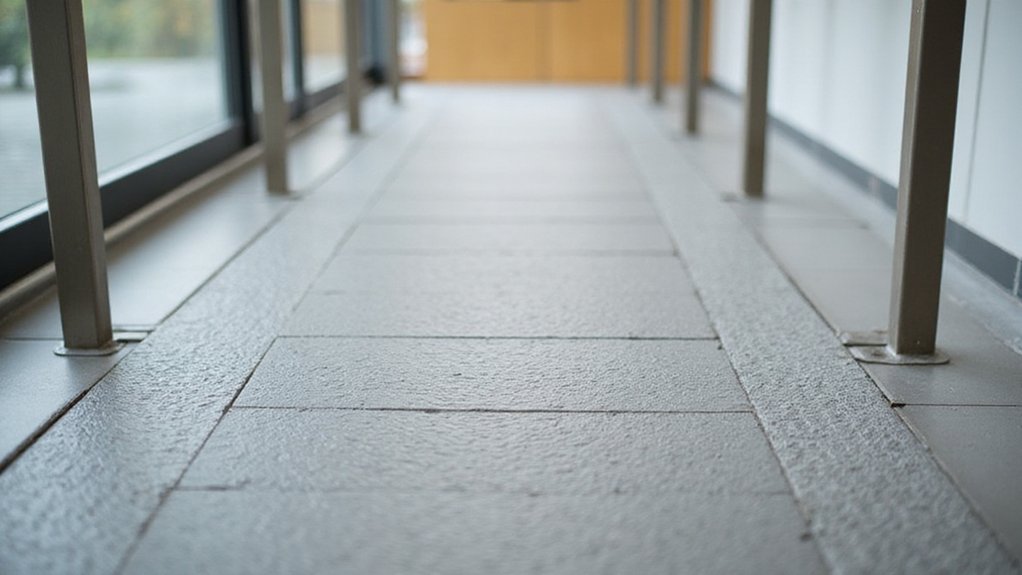Disclaimer: This content is for informational purposes only and does not replace professional medical advice, diagnosis, or treatment. Always consult a qualified healthcare provider before beginning any new exercise program.
Have you ever considered how the wrong flooring could compromise mobility and safety? When designing accessible spaces, you’ll quickly discover that not all surfaces are created equal. ADA compliance demands precise engineering of floor materials to prevent accidents and support independent movement. Slip resistance and cushioning aren’t just aesthetic choices—they’re critical safety parameters that can dramatically impact user experience. If you’re curious about the science behind creating truly accessible environments, you’ll want to explore the intricate world of flooring standards that protect and empower individuals with diverse mobility needs.
Key Takeaways
- Choose flooring materials with a Static Coefficient of Friction (SCOF) of at least 0.60 to ensure safe mobility for individuals with disabilities.
- Select surfaces like rubber, commercial-grade vinyl, and low-pile carpet that provide both slip resistance and effective cushioning for wheelchair users.
- Implement proper installation techniques, including beveling level changes greater than 1/4 inch and securing carpet edges to prevent tripping hazards.
- Prioritize dynamic slip resistance testing using standards like ASTM E303-22 to verify flooring safety in high-moisture and transitional areas.
- Balance surface firmness and shock absorption to reduce joint strain and enhance comfort for individuals using mobility aids.
Understanding ADA Flooring Requirements
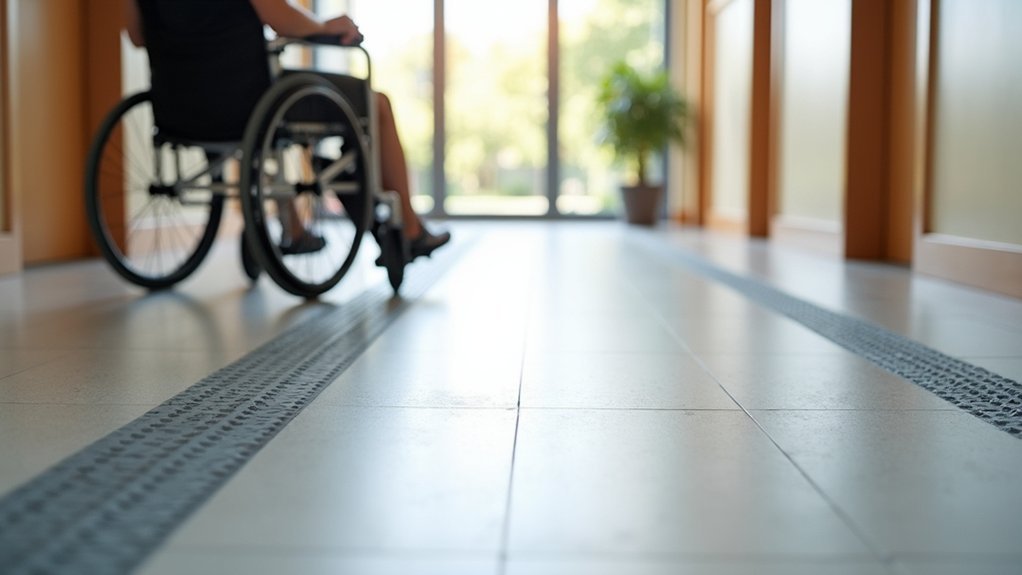
How can you guarantee your flooring meets essential accessibility standards? Understanding ADA requirements is vital for creating inclusive environments. The Americans with Disabilities Act mandates specific guidelines for flooring that support safe navigation for individuals using mobility devices. Your ADA-compliant flooring must prioritize slip resistance, with a static coefficient of friction (SCOF) around 0.60. Focus on durable materials like rubber and commercial-grade vinyl that withstand wheelchair traffic while providing stable surfaces.
When selecting flooring options, consider vertical changes carefully. Changes in level greater than 1/4 inch must be beveled with a 2:1 slope to prevent tripping hazards. Carpet selections should remain under half an inch thick and be securely fastened. By meticulously following these ADA standards, you’ll create accessible spaces that support mobility and safety.
The Importance of Slip Resistance
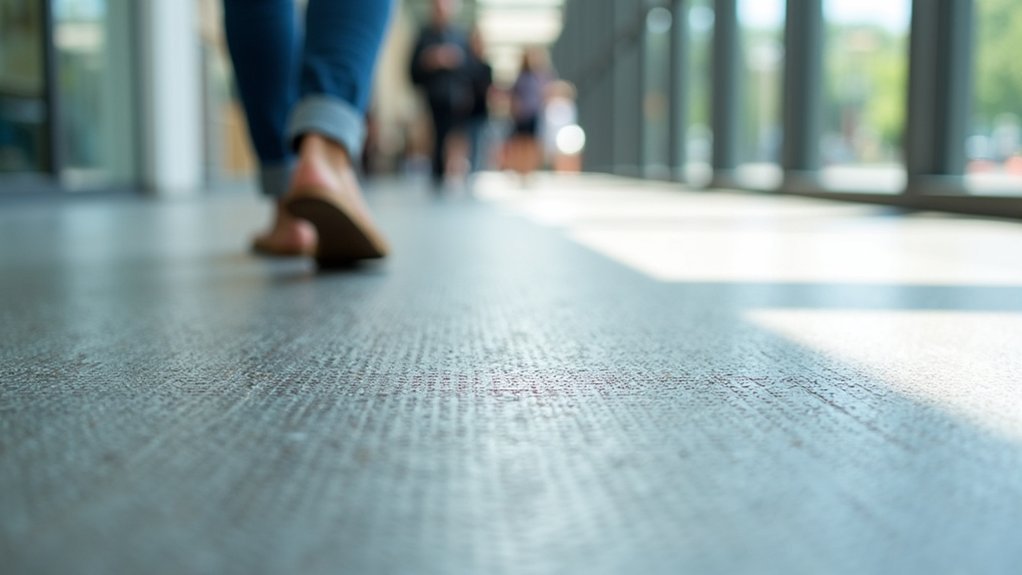
While ADA guidelines outline specific flooring requirements, slip resistance emerges as a paramount safety consideration for accessible environments. When designing spaces for individuals using mobility aids, you must prioritize surfaces meeting ADA slip resistance standards, specifically a static coefficient of friction (SCOF) of 0.6 or higher.
Your flooring choices directly impact user safety, particularly in high-moisture areas like bathrooms and entryways. Dynamic coefficient of friction testing using ASTM E303-22 provides critical insights into real-world surface performance. External ramps require particular attention, with recommended Pendulum Test Values of 55 or higher to minimize slip risks.
Ultimately, ADA-compliant flooring isn’t just about meeting regulations—it’s about creating genuinely safe, accessible environments for all users.
Cushioning: Comfort and Safety for Mobility
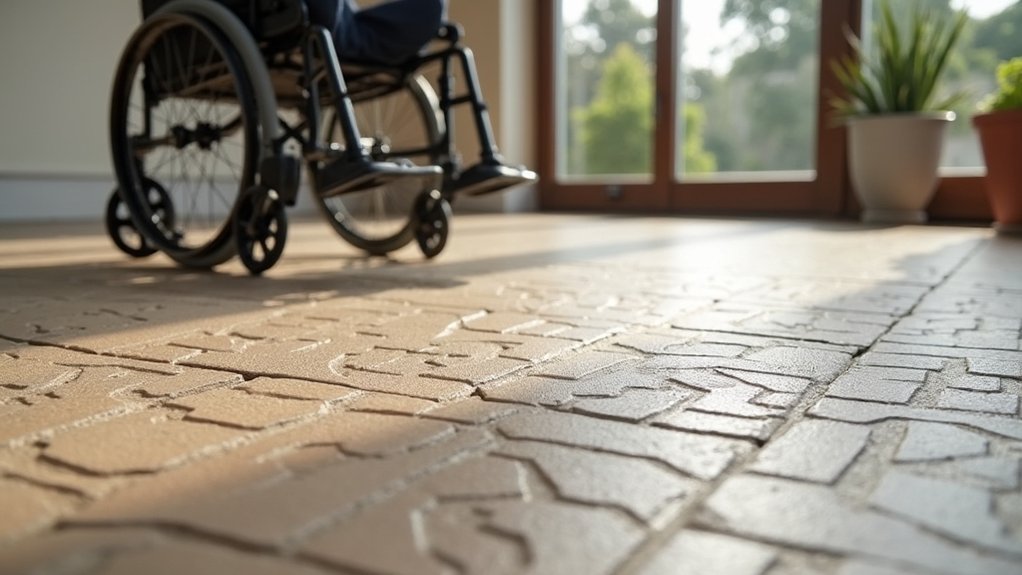
In ADA-compliant flooring design, cushioning emerges as a critical factor for mobility safety and comfort. When selecting flooring materials for public spaces, you’ll want to prioritize surfaces that provide impact absorption and support for individuals using mobility devices. Rubber and low-pile carpets offer excellent cushioning, reducing joint strain and enhancing traction. The right cushioning creates a stable environment that prevents slips and supports balance, directly addressing ADA guidelines for accessibility.
Your flooring choice should balance firmness with shock absorption, minimizing fatigue for wheelchair users and pedestrians. Enhanced cushioning also contributes to sound dampening, creating a sensory-friendly environment. By focusing on these technical considerations, you’ll develop ADA-compliant floors that prioritize both safety and comfort across diverse mobility needs.
Top Flooring Materials for Wheelchair Accessibility
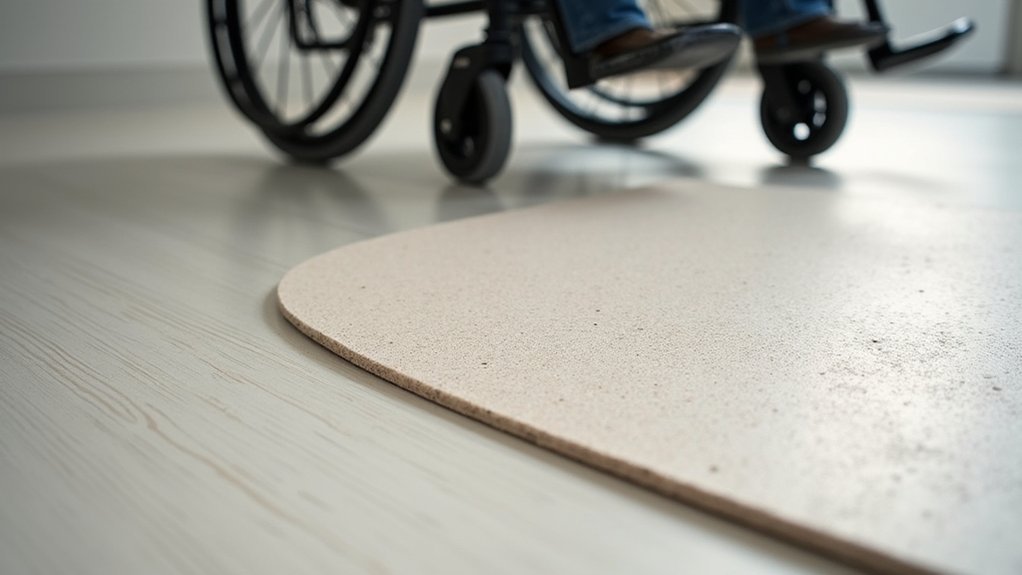
Wheelchair mobility demands flooring solutions that balance durability, safety, and seamless navigation. The flooring must guarantee accessibility by selecting materials that meet ADA Standards for commercial and public spaces. Vinyl flooring, particularly SPC and WPC options, provides a stable surface with superior wear layers and traction. Rubber flooring excels in slip resistance, offering impact absorption vital for wheelchair users. Ceramic and porcelain tiles with textured surfaces provide durability, while smaller tiles with grout lines facilitate easier wheelchair movement. Low-pile commercial carpet can also accommodate mobility when carefully selected. Critically, avoid loose rugs and foam tiles that compromise stability. Each material’s performance depends on precise installation, surface texture, and thickness to create an environment that supports safe, efficient wheelchair navigation.
Measuring Slip Resistance: Testing Standards

Because slip resistance directly impacts safety for individuals with mobility challenges, architects and facility managers must understand precise testing methodologies that quantify surface traction. ADA requires thorough slip resistance evaluation using recognized standards like the Pendulum DCOF test, which assesses dynamic coefficient of friction across diverse environments.
Key considerations for measuring slip resistance include:
- ASTM E303-22 as the current standard for slip resistance
- Minimum wet Pendulum Test Value (PTV) of 55 for external ramps
- Global recognition of Pendulum testing since 1971
- Importance of testing under various surface conditions
- Differentiation between static and dynamic friction measurements
Selecting accessible surfaces demands rigorous testing to guarantee safety, with professionals prioritizing scientifically validated methods that provide precise slip resistance values for critical mobility infrastructure.
Common Flooring Mistakes to Avoid
Maneuvering the complexities of ADA-compliant flooring requires architects and facility managers to recognize and prevent common design pitfalls that compromise accessibility. Loose rugs and unbeveled floor connections create significant hazards for individuals with mobility challenges. You’ll want to guarantee all carpet edges are securely fastened and that floor levels maintain smooth, beveled connections to prevent tripping risks.
When selecting flooring, prioritize slip resistance and carpeting thickness. The Americans with Disabilities Act specifies that carpet pile shouldn’t exceed half an inch, and surfaces must achieve a static coefficient of friction of 0.60. Overlooking these technical requirements can render a space non-compliant and potentially dangerous for wheelchair users. Careful material selection and precise installation are essential for creating truly accessible environments.
Designing Accessible Environments: Best Practices
While designing accessible environments demands meticulous attention to detail, architects and facility managers must prioritize thorough flooring strategies that seamlessly integrate ADA compliance with functional design.
Key considerations for creating accessible spaces include:
- Select floor mats and surfaces with textured loop patterns to enhance slip-resistant properties
- Implement beveled with a slope changes between different flooring types to eliminate tripping hazards
- Guarantee surfaces meet ADA standards for individuals with disabilities
- Incorporate rubber flooring materials that provide cushioning and improved traction
- Conduct regular maintenance inspections to verify continued compliance and safety
These strategic approaches help create environments that support mobility, reduce fall risks, and provide safe navigation for all users. By focusing on technical specifications and precise design elements, professionals can develop spaces that are both functional and inclusive.
Frequently Asked Questions
What Is the ADA Standard for Slip Resistance?
You’ll want to guarantee your flooring meets a 0.60 static coefficient of friction, using safety testing standards that evaluate slip resistance across different material types, prioritizing accessibility and user experience.
What Are the ADA Requirements for Floor Mats?
You’ll need ADA-compliant floor mats with beveled edges, maximum half-inch pile thickness, secured installation, slip-resistant surfaces (SCOF ≥0.60), proper placement, and regular maintenance to guarantee accessibility and safety for individuals with disabilities.
What Are the ADA Requirements for Flooring?
You’ll need flooring that meets ADA safety regulations, ensuring accessible design with stable, slip-resistant surface textures. Commercial buildings must follow precise installation guidelines, prioritizing mobility, with materials that facilitate safe navigation for all users.
What Are the ADA 303 Changes in Level?
Like a smooth dance between surfaces, you’ll navigate level changes effortlessly. ADA 303 guides surface shifts with precise accessibility guidelines: no edge treatment under 1/4″, beveled slopes 2:1 for 1/4-1/2″, and ramps beyond 1/2″ ensuring safety.
Conclusion
You might think maneuvering flooring regulations is a mundane task, but it’s far from it. By prioritizing slip resistance and strategic cushioning, you’re not just meeting ADA standards—you’re transforming spaces into inclusive environments. Ironically, these precise technical choices aren’t constraining; they’re liberating. Your careful material selection guarantees safety, comfort, and dignity for everyone, proving that accessibility isn’t a compliance checkbox, but a design philosophy that empowers mobility.
